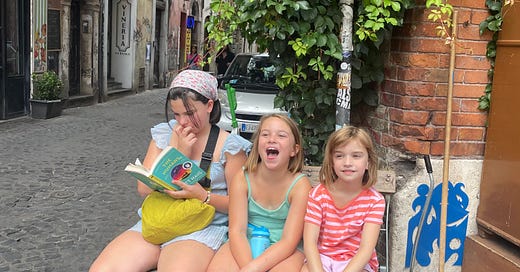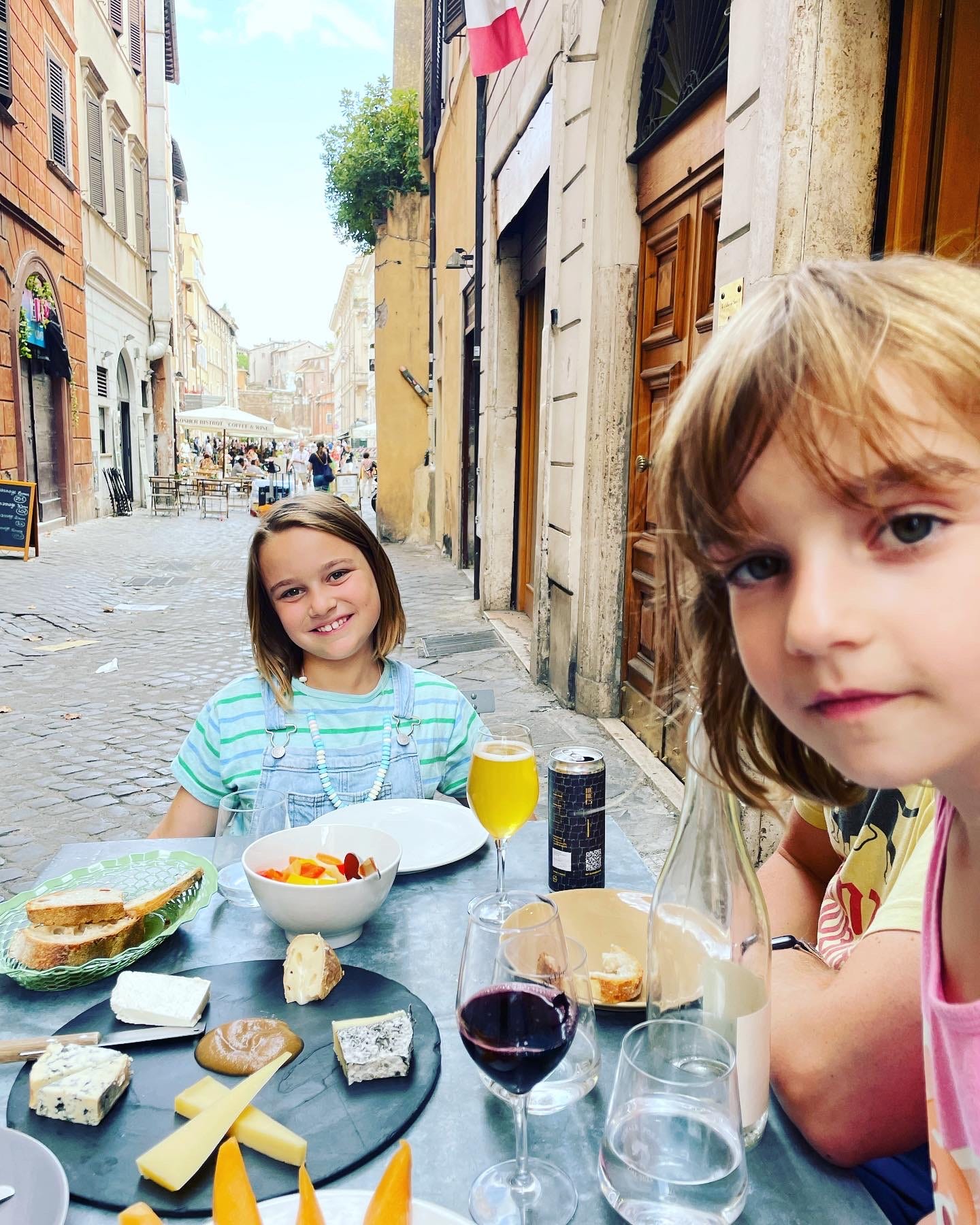11 Things I Learned After Spending 2 Months in Rome with 3 Kids
Some tips for bringing the fam to the Eternal City, including how to find an English-speaking pediatrician who makes house calls
A little less than two years ago, I was sitting in bed with my laptop, watching Parks and Rec reruns and poring over a spreadsheet entitled Summer 2022. After spending a couple of hours searching for local day camps and coordinating the logistics of what’s essentially week-by-week childcare for three little girls, I tallied the total. For just the month of August (five weeks) it would cost us roughly $7,500. Meanwhile, with most camps running from 9 a.m. to 3 p.m., between drop off and pick up I’d get little more than a half day of work each day.
Long before we had kids, my husband Eric and I talked about working abroad for a month or two. He works in tech and his job is remote, and as a freelance writer, I can also do my job from anywhere. We never had a forcing factor, though — until that moment. We could choose to spend a truly bananas amount of money for our daughters to make crafts, or we could spend the same (or less) on an Airbnb and plane tickets.
For the test run of our plan, we chose Rome because I speak passable Italian (thanks to spending my junior year abroad in Bologna and also Duolingo) and had visited the city several times before. Having a general working knowledge of the city felt like a necessity for taking the girls — at the time ages 10, 7 and 5 — for a relatively longer stretch of time. We found a no-frills apartment in Trastevere and booked our flights.
The first summer was such a success that we decided to do it again, this time to Greece. But after spending 40-odd hours researching and planning, the trip was upended only a few days in because of wildfires in region, and we ended up in Rome again. This time, instead of spending 4.5 weeks in one apartment, we spend 5.5 weeks in three different ones, plus two hotels. Not ideal, but the upside was getting to know four neighborhoods pretty well. We were also supremely lucky enough to get to know the city in a way that goes beyond a week-long vacation.
Below, I’m sharing 11 things we learned from spending two-plus months in Rome, including where to find clean restrooms, why you should dine at the train station, and how to book an English-speaking pediatrician who makes house calls.
Pack reusable water bottles
2,500 water fountains are scattered throughout Rome, continuously spout clean, cold water from the city’s aqueducts. Bring at least a few water bottles (Takeya was great for us, no leaking) and you can refill as you find them, or download this app Eric found that shows where they are nearest to your location.
If you don’t have a water bottle, you can still drink from them by plugging the spout with your finger — water will spray from a small hole on the top of the spigot like a drinking fountain. (It sounds gross, it’s actually great.) Aside from, you know, hydrating us, the water fountains were also great for pure entertainment. The girls were super into seeing how high and far they could spout the water, which made for lots of laughs and only a few soaking incidents (themselves, not strangers, TG.)
Make lunch your main meal
I remember the day I arrived in Bologna — I was 20, and it was only my second time in Europe. Exhausted from the overnight flight and wanting to go to bed early, a few of my classmates and I tried to find a place to eat dinner in the city center around 5 p.m. Two decades later, I’m still utterly chilled by the look on the woman’s face when we asked if they had a table. The didn’t open for two more hours, she told us.
These days, you can certainly find places to eat on the earlier side in Rome, but most great restaurants don’t open until at least 7 p.m., and even if you get a table the minute they open, a deeply ingrained lack of hustle (in the best way!) means you might be at dinner until 10 p.m.
So especially if you have young kids or babies, I highly recommend planning to make lunch the big meal of the day. Lots of great spots are open for the mid-day meal, and you’ll enjoy it more if you’re not worried about meltdown-o-clock. A few of my favorite lunchtime meals are at Da Cesare (a bus ride, but worth it for the lovely patio and stellar fried gnocchi atop cacio e pepe sauce.), Cesare Pellegrino (owned by the same family, who recently reopened the beloved classic trattoria), SantoPalato (get the meatball) and Roscioli.
Don’t stay in the historic center
First instinct may be to stay in the heart of Rome for the convenience of seeing the major attractions, and if you only have two or three days, it might make the most sense. But if you have a few more days, make your home base a teeny further out, like in Trastevere, Monti, or Testaccio. It’s an easy walk (or depending on their walking abilities, short bus ride) from these neighborhoods to the city center, but you’ll also get to spend time in a quieter, less tourist-saturated area and experience the rhythms of the locals. Have morning cappuccino at the same cafe each morning, sit for an aperitivo in the same piazza while your kids run around with the local kids.
We stayed near Piazza di S. Cosimato in Trastevere the first summer, and many evenings we’d get post-dinner gelato at Otaleg and let them romp around the playground. They made lots of friends, even if they didn’t speak the same language. (Side note: in my experience, Romans can be a little bristly, but when you visit a place for a second time they’ll likely remember you and be warmer.)
Dine at the train station
I know this sounds unhinged, but I am a full-throated fan of eating at the Roma Termini, even if you aren’t taking the train. Mercato Centrale Roma is a food court located just past the COIN department store on the south side of the station. Inside, 20-ish stalls sell everything from pizza al taglio (cut and weighed to order) and cream-filled donuts to fresh pasta dishes. There’s even a Trapizzino stall in the back. After you collect your food, bring it to one of the tables and a server will come around and take your drink order. (Another plus: clean restrooms.)
Keep reading with a 7-day free trial
Subscribe to The Carry On to keep reading this post and get 7 days of free access to the full post archives.






